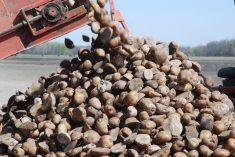“Greater clarity” in federal guidelines for the makeup and labels of “simulated” meat and poultry products is the end zone for a new round of consultations underway for the next month.
The Canadian Food Inspection Agency on Tuesday announced the launch for the public consultation, which includes an online survey and runs until Dec. 3.
Ottawa’s proposed updates “seek to clarify what constitutes simulated meat or poultry products” in keeping with the Food and Drug Regulations and Safe Food for Canadians Regulations, the government said.
Read Also

Senft to step down as CEO of Seeds Canada
Barry Senft, the founding CEO of the five-year-old Seeds Canada organization is stepping down as of January 2026.
The guidelines in question outline the rules for” labelling, advertising, composition and fortification for such products,” the government said, and making those guidelines clearer “will better support industry in their understanding and application of the regulatory requirements.”
The new guidelines would draw clearer lines between simulated meat and poultry products and “those that are neither meat nor poultry and not intended to substitute for meat or poultry products.”
While changes are proposed for the federal guidelines, the regulations on which they’re based will not change, CFIA said.
Consumers taking the online survey can share how familiar they are with these products and show what label information is important to them, the agency said.
“The consumer perceptions of these foods will advise industry on how they can better position their products in a manner that is truthful and not misleading, as required by the regulations, and provide information that supports informed buying decisions for consumers.”
The current guidelines for “simulated meat and simulated poultry products” are supposed to apply specifically to products made to resemble meat or poultry products.
Among the more recent arrivals in that category are plant-based burgers “made to look like a beef burger by using ingredients that simulate the red colour or fat marbling effect of animal-sourced meat.”
The rules today require that consumers “must not be misled as to the true nature of these products,” which means a complete common name — for examples, “simulated beef,” “simulated chicken” or “simulated tenderloin” — must appear on labels and in ads for all such products.
Simulated meat and/or poultry products also must carry the phrase “contains no meat” and/or “contains no poultry” on the principal display panel of the label near the food’s common name and in letters at least the same size as the common name.
If simulated meat is used as an ingredient in another food, such as a soup, a “contains no meat” declaration isn’t required, but pictures and vignettes on the packaging of the final food “must not suggest that meat is present.”
The Food and Drug Regulations also lay out specific amounts of vitamins and minerals that must be added to simulated meat and poultry products and declared on their “Nutrition Facts” labels — as well as minimum protein ratings for simulated meat products.
CFIA said Tuesday it “also recognizes there is a need to update the guidelines to include food products that are plant-based proteins which are not intended to resemble or substitute a meat or poultry product.”
Examples in that category include “properly identified” tofu burgers, lentil loaves and soy patties.
Unlike the new plant-based burgers on the market, such products “may have a colour or texture similar to that of a meat or poultry product” but have “characteristically identifiable nonmeat ingredients and are not aiming to be like a meat product.
“For example, a soy burger may have discrete nonmeat ingredients such as corn, seeds, entire lentils, or other cereals and legumes.”
For comparison, the guidelines today require a product labelled as “Simulated Bacon Bits” to be nutritionally equivalent to real bits of bacon and meet compositional rules under the Food and Drug Regulations — but a product labelled “Bacon Flavoured Bits” doesn’t imply a simulation, just a flavour, so rules on nutritional equivalence and composition don’t apply.
For plant-based but non-simulated products, naming an animal species or meat cut that draw a comparison to meat, on the label and/or in ads, would not be allowed under the new guidelines.
Claims such as “vegetarian,” “veggie” or “plant-based” can be made on those goods, as long as they’re “not used in conjunction with terminology that promotes the product as equivalent to meat.” For example, calling a product a “chicken-flavoured veggie burger” would be allowed.
“The growth in Canada’s plant-based foods industry indicates the need for clearer guidelines to better support industry in their understanding and application of regulatory requirements,” Agriculture Minister Marie-Claude Bibeau said in Tuesday’s announcement.
“We’re working to bring that clarity which includes a better understanding of consumers’ views and needs to allow them to make more informed food choices.”
According to the National Research Council Canada, total protein demand worldwide is expected to double to 943.5 million tonnes in 2054, but alternative proteins, including plant-based proteins, are expected to grow up to a third of that market, at rates of up to 14 per cent annually by 2024.
Worldwide, the NRC said, the plant-based protein market alone is expected to reach US$10.8 billion by 2022. — Glacier FarmMedia Network




















